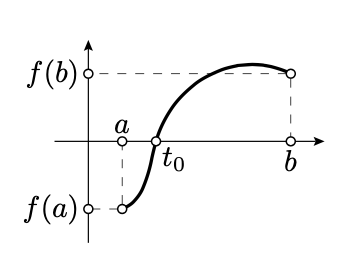3.2: Intermediate Value Theorem
- Page ID
- 23592
Let \(f: [a, b] \to \mathbb{R}\) be a continuous function. Assume \(f(a)\) and \(f(b)\) have opposite signs, then \(f(t_0) = 0\) for some \(t_0 \in [a,b]\).

The intermediate value theorem is assumed to be known; it should be covered in any calculus course. We will use only the following corollary:
Assume that for any \(t \in [0, 1]\) we have three points in the plane \(O_t\), \(A_t\), and \(B_t\), such that
- Each function \(t \mapsto O_t\), \(t \mapsto A_t\), and \(t \mapsto B_t\) is continuous.
- For any \(t \in [0, 1]\), the points \(O_t, A_t\), and \(B_t\) do not lie on one line. Then \(\angle A_0 O_0 B_0\) and \(\angle A_1 O_1 B_1\) have the same sign.
- Proof
-
Consider the function \(f(t) = \measuredangle A_tO_tB_t\).
Since the points \(O_t, A_t\), and \(B_t\) do not line on the one line, Theorem 2.4.1 implies that \(f(t) = \measuredangle A_tO_tB_t \ne 0\) nor \(\pi\) for any \(t \in [0, 1]\).
Therefore, by Axiom IIIc and Exercise 1.9.2, \(f\) is a continuous function. By the intermediate value theorem, \(f(0)\) and \(f(1)\) have the same sign; hence the result follows.


